A mole in medicine is called a melanoform nevus. In general, education is not dangerous as long as its status quo is maintained. But if any changes begin in the color, structure or size of the nevus, you should immediately consult a doctor. Especially if a black dot appears on a mole, because this may be a sign of a dangerous cancer condition.
Causes of blackheads
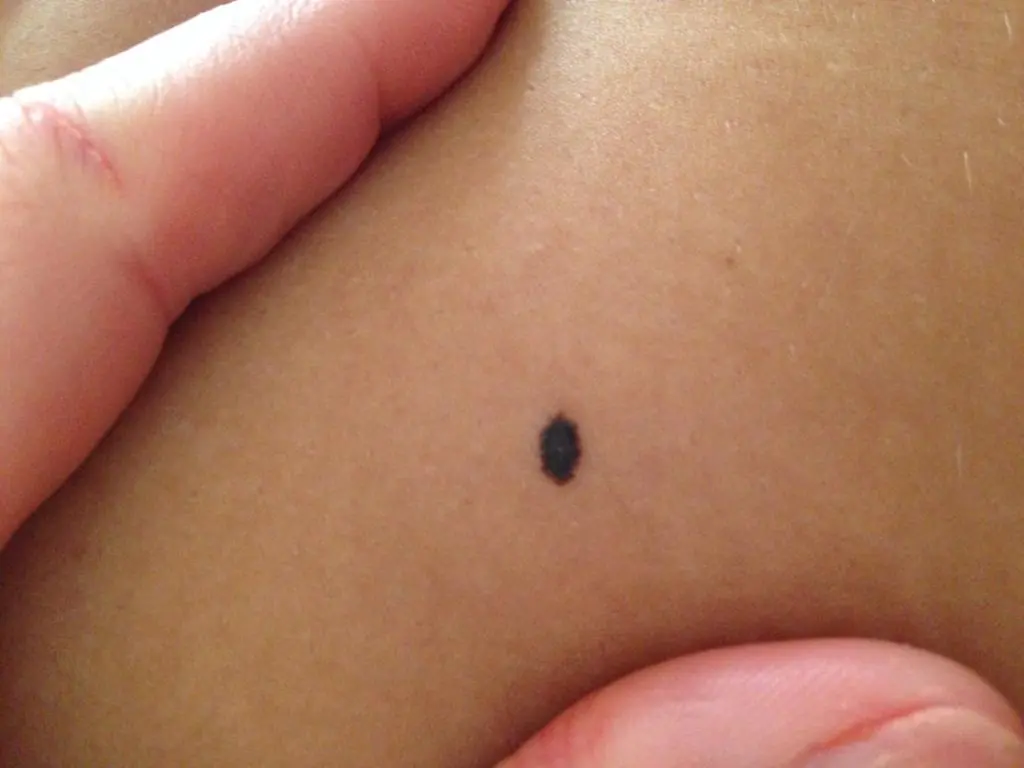
Typically, blackheads appear for the following reasons:
- Physical and mechanical damage to the mole. Basically, nevi have the shape of a hemisphere, slightly raised above the surface of the skin; accordingly, the formation is most easily touched by clothing, a nail or other object. Moles are much more sensitive to pain than ordinary skin, so a person notices such an injury immediately.
- Effect of solar ultraviolet radiation. Such radiation is dangerous for the body, especially for the skin. The process of the appearance of blackheads is quite simply explained. This is a protective reaction of the body associated with increased accumulation of melanin in the area with the mole.
The danger of blackheads
If a black dot appears on a mole, then this is a sign that some processes have begun to occur in it, which are not always safe for health. There are several reasons for this:
- If black dots appear on a brown mole, it may be superficial spreading melanoma. This neoplasm most often occurs in middle-aged women. Over time, the black dot that appears inside the mole grows, completely changing the color of the nevus to black or blue. After this, the formation begins to increase in size, changing its shape. It becomes hard and rough to the touch. If treatment does not begin at this stage, then the mole subsequently begins to secrete ichor and blood when pressed, and becomes painful even when its surface is lightly touched.
- A mole with a black dot in the center may be nodular melanoma. This type of nevus develops within a very short time, which increases its danger significantly. The formation quickly turns black, increases in size several times, and when ripe, begins to ooze blood and ichor. There is no drug treatment for this type of tumor. It can only be removed surgically.
- Acral lentiginous melanoma affects mainly children who spend most of the day in the open sun. And if a black dot appears on your leg like a mole, most often on the sole of the foot, then most likely it is this type of nevus. It develops extremely quickly and if left untreated, it turns into a malignant tumor.
Sometimes numerous black dots on a mole are normal. This new growth is called Hutchinson's freckle. They occur in older people against the background of pigmented age spots. Such moles grow slowly and can reach 10 cm in diameter. It is necessary to treat these formations, as they are extremely painful and constantly ooze ichor mixed with blood.
Possible complications
When a black dot appears on a mole, this is already a complication. That is, this condition is abnormal, and if urgent treatment is not started, the complications can be much more dangerous and severe.
First of all, these are metastases to organs adjacent to the mole. They can affect internal organs such as the liver, lungs, kidneys, and stomach. A simple-looking mole may be an indicator of cancer.
Another complication concerns the largest organ in humans - the skin. Melanoma leads to skin lesions with multiple moles, making a person’s appearance repulsive. Especially when they cover the arms, face, neck and other exposed areas of the body.
There are known cases of moles covering almost 100% of a patient’s skin. The situation is further complicated by the fact that melanomas that have developed from ordinary moles are extremely painful. Any touch causes bleeding and severe pain.

The most dangerous complication is the penetration of metastases from melanoma into the human brain. If the central nervous system is affected, the patient's death may occur suddenly, without apparent cause and without a long illness.
Additional symptoms
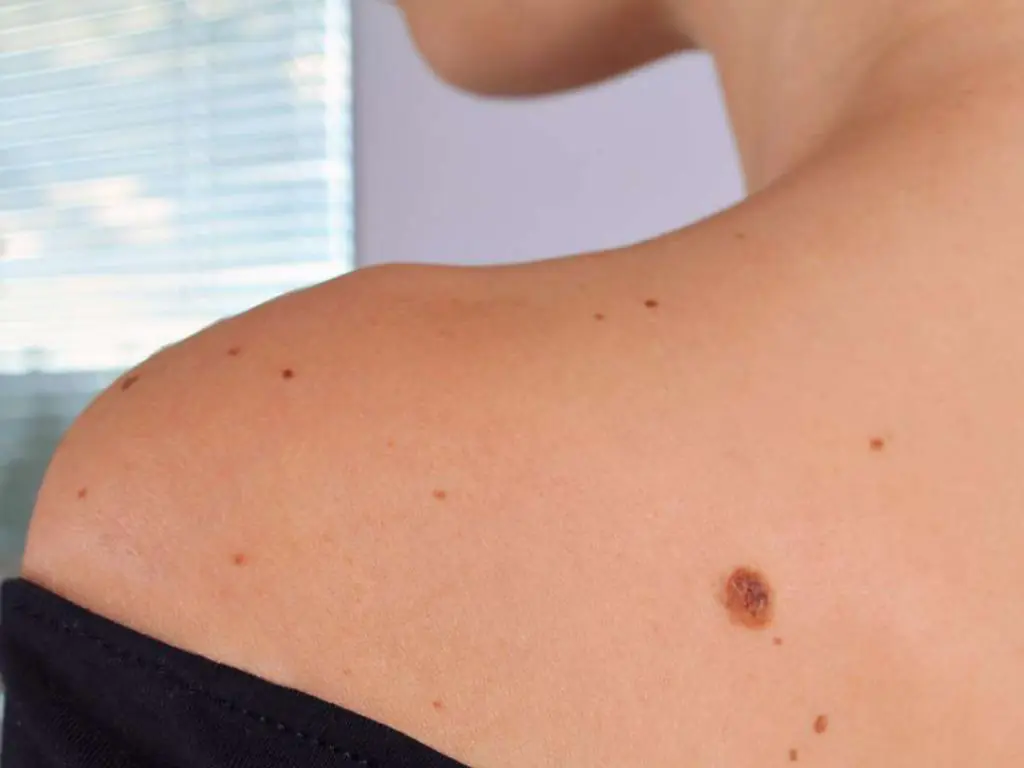
If a black dot appears on a mole, then this is definitely a bad sign and you should consult a doctor. But this is not the only symptom that indicates the beginning of the development of a dangerous condition in the body. The following manifestations are usually observed:
- The skin around the mole is itchy and itchy. An attempt to scratch the mole itself leads to injury and bleeding.
- The hair follicles on the skin around the mole are destroyed and the hair falls out. This is especially noticeable on the scalp.
- The spot itself is black and appears anywhere in the mole - on the side, in the center, on the edge.
- A mole with a spot grows rapidly, increasing several times within 2-6 months.
- The surface of the nevus cracks and oozes liquid. If the situation is left untreated, the mole gradually turns into a bleeding ulcer.
- Pigment spots appear on the skin around the mole.
If the skin around the mole turns red, this means that the body’s immune system is trying to get rid of the tumor and needs help at this moment. Usually a course of treatment and strengthening the immune system is sufficient.
Diagnostics
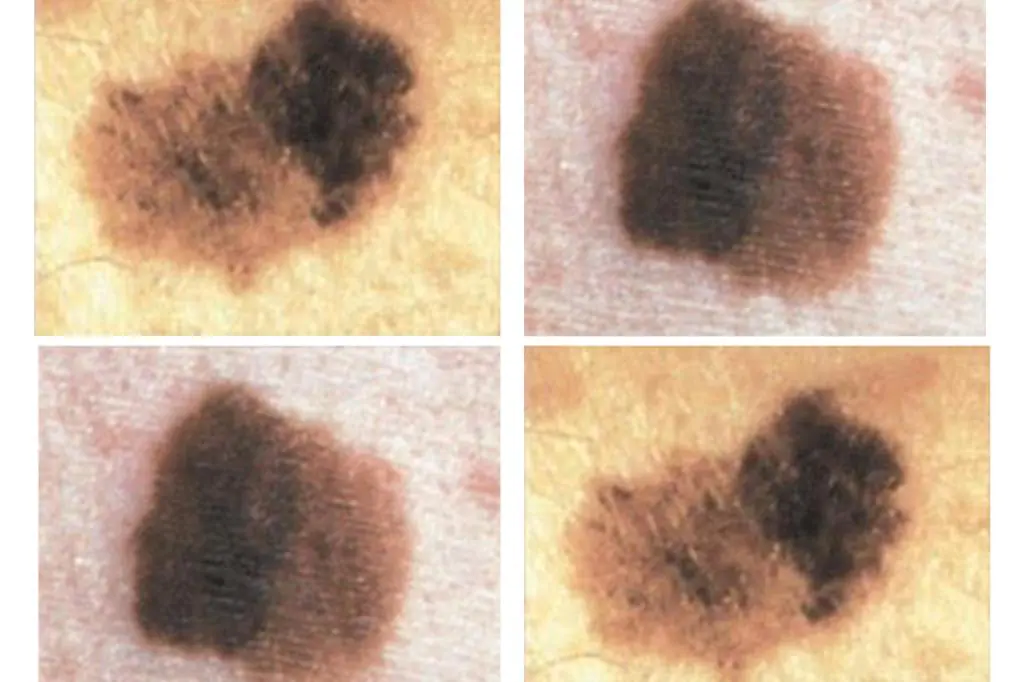
The primary diagnosis to determine the degree of danger of a mole can be made independently. And if there are signs that a mole is turning into a dangerous melanoma, you should urgently contact a specialist.
First of all, you need to remember that if a mole has become larger or more prominent, this is a bad sign.
Other dangerous symptoms are changes in the color of the mole, its borders, density and sensitivity. You need to pay attention to all this, since the doctor will definitely ask about the dynamics and nature of changes during the history taking.
The second stage of determining why black dots appear on a mole is laboratory research. With their help, the composition of the blood, the level of leukocytes in it, hemoglobin, platelets and the erythrocyte sedimentation rate are determined. Any abnormality in these measurements indicates a problem. The performance of the kidneys, liver and protein metabolism will be indicated by the result of a patient’s urine test.
Clarifying the diagnosis
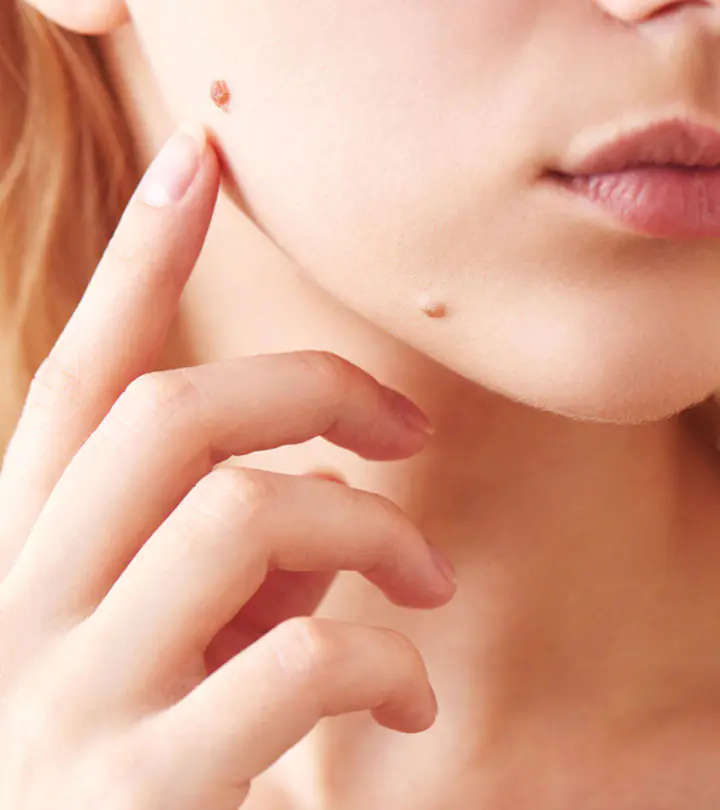
To clarify the diagnosis, various instrumental diagnostic methods are used. For example, dermatoscopy using a device that visually determines the danger of a mole. To exclude cancer, a histological examination of the tissue of the mole and the skin around it is carried out. In some cases, radiography or computed tomography of the affected skin area is used.
Conservative treatment
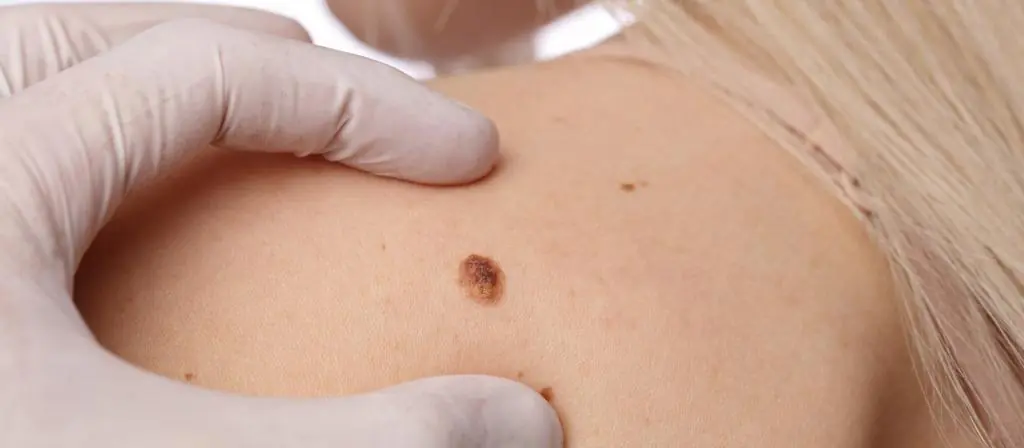
Conservative treatment of moles with a black dot is ineffective, since the very presence of inclusions indicates that the situation has become more complicated and complex treatment is required. Usually the mole itself is treated with Viferon, Foresol, Paneavir and other similar drugs that penetrate deeply into the thickness of the skin. In this case, the patient undergoes a course of treatment with vitamin complexes and immune-strengthening drugs, such as Isoprinosine and the like. All medications are prescribed by a doctor after a thorough diagnosis; self-medication is contraindicated in this situation.
Surgical treatment
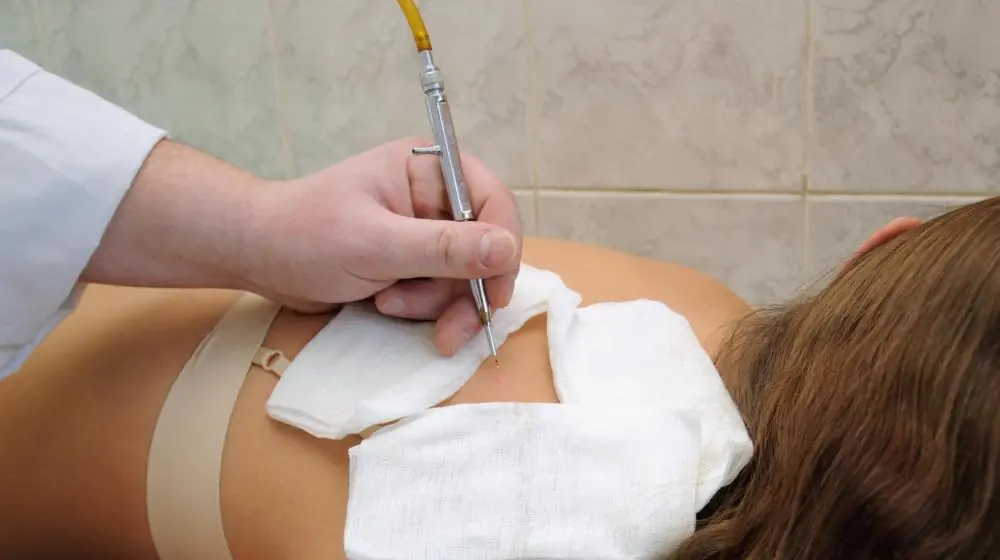
A mole affected by a blackhead can be removed in several ways.
- Laser therapy. During this procedure, the mole is burned layer by layer with a thin laser beam. This allows you to destroy exactly the affected tissue without affecting healthy skin. The procedure is bloodless, so the patient does not face any risk of infection or long healing. He can go home immediately after the operation. The only disadvantage of this removal method is severe pain, so before the procedure the patient is anesthetized for the surgical field.
- Electrocoagulation. This method is similar to laser therapy, except that the affected mole is removed with a powerful electric arc.
- Cryodestruction. This method is used to remove small moles by freezing them with a special substance. The procedure is painless and quick. After it there are practically no scars left.
- The classic method of removing moles is by cutting them out of the skin. After such an operation, a bleeding wound remains, which over time turns into a scar.
Treatment with folk remedies
There are several methods for treating moles using traditional medicine and medicinal plants. These recipes can be used only with the permission of a doctor and only if the mole does not pose a danger to humans. That is, it did not turn into melanoma.
One of the most famous methods in this direction is a compress on a mole made from grated garlic and lemon. It is believed that daily use of this remedy will make the mole disappear within a week.
Another compress is baking soda with castor oil. The preparation is simple - castor oil and soda are mixed in equal proportions until a homogeneous mass is obtained. Apply to the mole for 5 days, and for 10-12 hours. After this, the neoplasm resolves.
You can tie a fresh cut of celandine to the mole, having previously smeared it with the juice of this plant.
Prevention of melanomas
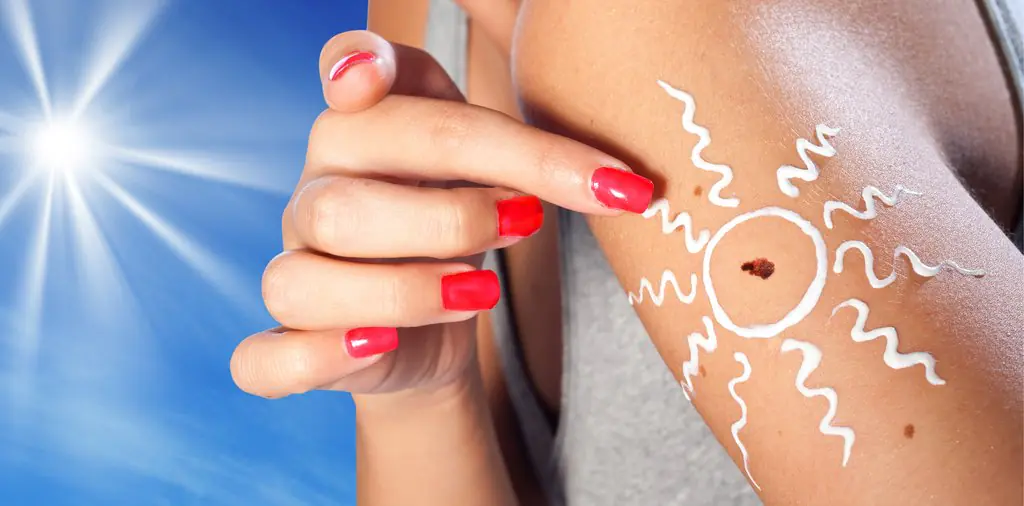
To ensure that moles on the body do not turn from harmless formations into dangerous melanomas, you need to follow the rules of prevention:
- Do not appear in strong sun without clothing and a hat.
- On the beach or near the pool, you need to treat your skin with a protective cream.
- You should not overuse visits to solariums, especially if you are predisposed to the appearance of moles and freckles.
- If there is a suspicious change in the shape, color or size of a mole, you should immediately consult a doctor.
Conclusion
You need to understand that the sooner you start treatment, the more favorable the prognosis will be. Even if a person has been diagnosed with stage 1 cancer, he has a good chance of a complete cure. Thus, the main thing in this matter is not to waste time. At the first symptoms of a mole degenerating into melanoma, you should visit a specialist to determine further actions.
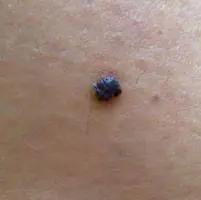
Nevi are benign skin growths that are brown or beige in color and are the result of the accumulation of melanin in the cells of the dermis. They do not pose any particular danger, unless, of course, they are subjected to frequent injuries and prolonged exposure to ultraviolet radiation. Dermatologists recommend not touching such growths if they do not cause physical or aesthetic discomfort.
But what does it mean if a black mole forms on the body? Isn't this a dangerous sign and a reason to immediately consult a doctor? Such neoplasms are not to be trifled with, and it is better not to try to remove them yourself. There are several possible options for why a dark nevus forms or a black dot appears on a mole, and we will consider them in as much detail as possible.
Main causes of dark pigmentation
A black dot in a mole should not always be alarming. And even more so, you should not panic about this ahead of time, since the reasons for the change in the color of the skin growth may not be related to its malignancy. Let us dwell in more detail on the main factors that can provoke such changes.
Changes in hormonal status
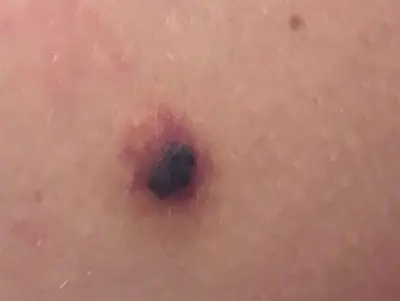
If a mole turns black, it is quite possible that this happened due to a sharp change in hormonal levels. Such changes can be both physiological and pathological. But most often, changes in the color of the nevus occur in adolescents during puberty, as well as in pregnant women. Menopause is another reason why a mole turns black.
Exposure to ultraviolet rays
Ultraviolet rays themselves are a negative factor affecting nevi. Under their influence, the growth may well degenerate into a malignant tumor, so people who have many such tumors on their body should exercise special caution. If you notice that after sunbathing on the beach or in a solarium you have a brown mole with black dots, then you need to reduce the period of stay in such areas to a minimum.
Nevus damage
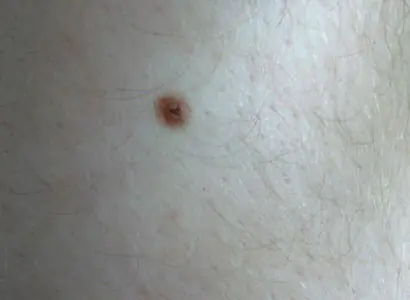
Another reason why a mole turns black and hurts lies in a mechanical violation of its integrity. This can happen for any reason:
- during bathing due to intense friction of the growth with a washcloth;
- when wearing tight or tight clothing;
- while shaving;
- when scratching the skin in the area where the nevus is located, etc.
There are many options, but the reason for a mole with a black rim in this case is the same - it is mechanical damage.
Dysplastic nevus
A dark mole may be a dysplastic nevus - a neoplasm that can appear anywhere on the body and has the following parameters:
- the neoplasm has a diameter of more than 5 mm;
- nevi are flat and may have uneven edges;
- growths may have inclusions of different shades;
- the central zone of the tumor is slightly elevated.
On a note. People who have a black dot on a mole, or the resulting spot is initially dark in color, are at risk of developing skin cancer. The most terrible disease is melanoma, which has a tendency to rapidly progress and metastasize to internal organs. Therefore, with such neoplasms, it is imperative to consult a doctor.
Endocrine disorders

The previously discussed hormonal reasons why black moles appear on the body are physiological. That is, they are closely related to the processes occurring in the human body and are considered completely normal.
But there are endocrine disorders that are pathological, and they may well provoke the appearance of new pigmentation, or cause darkening of nevi existing on the body. These include:
- Diabetes. One of the reasons for the formation of black moles on the body is such a dangerous endocrine disease as diabetes. It is accompanied by metabolic disorders, which cannot but affect the condition of the skin.
- Diseases of the thyroid gland - thyrotoxicosis or hypothyroidism. These pathological syndromes are also common causes of the formation of a black spot on a mole. This is especially true for hypofunction of the thyroid gland - hypothyroidism. With this disorder, all metabolic processes slow down, and significant changes occur in the functioning of the skin. As a result, nevi may darken and also begin to become inflamed more often.
Disorders in the functioning of the adrenal glands can also cause the appearance of a mole with a black dot in the center. Disturbances in the production of cortisol, adrenaline and norepinephrine tend to affect the skin, so you should not be surprised if even clean areas of it become somewhat darker.
Is darkening of a nevus dangerous, and when should you see a doctor?
If a mole turns black, what does it mean, and could it be a dangerous sign? Unfortunately, this option cannot be ruled out. The risk of degeneration exists even with an ordinary mole, and if it was originally black, then this probability increases several times.
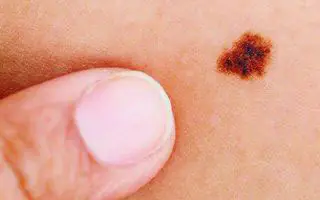
What signs should you look out for?
The fact that a small black mole has appeared is not enough to raise suspicions about it. To be concerned and seek help from a doctor, the growth must:
- was asymmetrical;
- had “spreading” contours;
- acquired a “suspicious” color - too dark or, conversely, light;
- appeared above the skin.
Also considered suspicious are moles that:
- often become inflamed;
- have a wet surface;
- become crusty;
- are growing rapidly.
A black mole requires immediate medical attention if it itches, burns, and drops of blood periodically appear on its surface. Also, a situation where the skin around the nevus is in a constantly inflamed state is considered completely unsafe. If it also gets darker, then you need to make an appointment not with a regular dermatologist, but with a dermatologist-oncologist.
What do such growths mean?
If a mole has darkened, what does it mean? At best, this means that it is going to fall away. This can take a long time, so don't expect the process to be lightning fast.
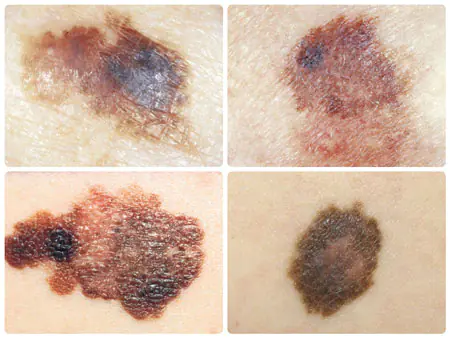
To begin with, you may notice that the mole begins to turn black, then it may peel off. Ultimately, it disappears completely. This can happen either a few days after the nevus darkens or several weeks later.
If crusts form on a mole, why it is dangerous, read the link
In the worst case, a black nevus will indicate that the process of degeneration of its tissues into a malignant skin tumor - melanoma - has been started. All of the above alarming symptoms are characteristic of it.
This is an extremely dangerous cancer that requires immediate treatment. If the patient does not receive it, he risks serious complications from the functioning of the internal organs. With advanced melanoma, the consequences can be fatal, that is, fatal.
Diagnostic features
If a mole changes color to a darker color, then first you can consult a dermatologist. Especially if you do not have the opportunity to undergo an initial examination by an oncodermatologist.
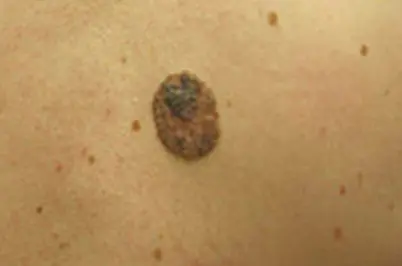
To begin with, the doctor conducts a detailed survey to determine whether there are any complaints about the presence of inflammatory pain and other alarming symptoms. He must find out whether the black mole was on the back or other part of the body before, or appeared recently. What was its size, does it bleed, how often does it become inflamed, etc.
Next, a detailed study of the growth must be carried out using a magnifying glass. Although the eye of an experienced specialist can detect suspicious features of a neoplasm even without a lens. But this is not enough.
After a visual examination of a black dot on the body, similar to a mole, the doctor must make a preliminary diagnosis, and then prescribe a biopsy. This procedure is the most informative in such a situation. A piece of tissue from the surface of the neoplasm is selected using a scraping or a special needle and sent for microscopic (histological) examination. The results may be as follows:
- A mole with black spots is benign. In this case, the option of removing it, if the patient himself wants it, is selected together with the attending physician.
- The strange mole has not yet begun to degenerate, but atypical cells have already been discovered. Such a tumor is removed urgently to prevent the development of skin cancer.
- A black mole on the back is melanoma. This is the most dangerous option, requiring immediate medical intervention to avoid dangerous complications.
Thus, we figured out why dark moles on the body are dangerous, and what properties they may have - benign or malignant. Now let’s briefly consider options for solving the problem, taking into account the characteristics of the skin growth.
Methods for removing dark nevi
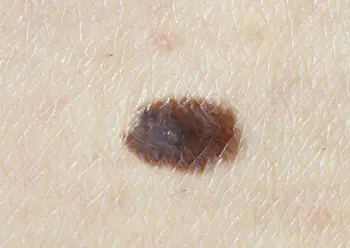
If a black dot on the skin, like a mole, is not a malignant neoplasm, does not become inflamed and does not cause any discomfort, then you don’t have to touch it. But sometimes such neoplasms greatly spoil the appearance and are also subject to injury, which can lead to serious consequences. In such circumstances, it is recommended to remove them by:
- Laser coagulation. Using a laser beam, the neoplasm is carefully excised, and in its place a black crust forms - a scab. The manipulation is bloodless, since the beam is heated to high temperatures. The procedure is painful, so it is performed under local anesthesia, for which lidocaine is usually used. Under no circumstances should the scab be removed - it must come off on its own. Otherwise, a scar will form in place of the former nevus, which will take a very long time to resolve.
- Cryodestruction. The growth is removed using liquid nitrogen, which is supplied through a special apparatus. Most clinics use Surgitron for this.
- Electrocoagulation. A black raised mole is excised using an electric knife, which, like a laser beam, immediately cauterizes the treated area. Thanks to this, the resulting wound does not bleed and heals much faster.
- Radio wave therapy. The tumor is excised with a radio knife and does not appear again.
If black dots on the body, similar to moles, are melanoma, and this is confirmed by histological examination, then the above-described instrumental procedures are not performed. In this case, the tumors are excised with a scalpel, that is, radical surgery is performed.
Of course, it is not a guarantee that a relapse of the disease will not occur. But if this is not done, the consequences of melanoma will be catastrophic.
A person who has many moles on his skin generally never pays attention to changes in their color. Black dots on a mole do not appear by chance; there are various reasons for their occurrence. If the dots do not disappear from the surface of the mole for a long time, you should immediately consult a doctor and find out the nature of the neoplasms. What are the causes of discoloration of nevi, and what is their danger?
Causes of dark spots on a mole
Black dots on a mole appear for the following reasons:
- Any injury. If a mole is localized on an open area of skin that is subject to constant contact with clothing or simply interferes with life, then it is very easy to damage it. When touched, the mole bleeds and becomes painful. In any case, if the growth is damaged, you need to observe it for several days.
- A warning that a benign neoplasm is turning into malignant. Prolonged exposure to the sun often provokes a similar sign of melanoma. Black spots appear on the nevus and do not go away for a long time. In this case, you should consult a doctor and determine the nature of the neoplasm.
- Decreased immune defense of the body. Due to weakened immunity, a black mole may appear, which disappears after the provoking factor is eliminated.
- Hereditary predisposition.
- Hormonal imbalances in the body (pregnancy, menopause, taking hormonal medications).
Is there any danger?
The color of the skin and the number of nevi depend on the content of the natural pigment - melanin. Melanocytes are the cells of the body responsible for its production. Black spots on a mole are the result of pigment deposition. The more active the production of melanin is, the darker the pigment spots on the human skin become.
Convex moles are considered the most dangerous; they often have a regular shape and a characteristic even color. You should carefully monitor the appearance of the tumors. Very often, a change in the appearance of a nevus is accompanied by signs that indicate the degeneration of a benign tumor into a malignant one. If black dots or a brown spot appear on a mole, you need to consult a doctor and, if necessary, be examined.
Preventing the appearance of blackheads
To prevent negative health consequences, you should consult a doctor at the first sign of changes in a mole. Ultraviolet radiation often provokes such skin changes, so you should avoid prolonged exposure to the sun, hide nevi under clothing or stick a patch on top (only on problematic growths). After swimming, you should immediately dry your skin with a towel, as small droplets of water increase the effect of sunlight. If a person is fair-skinned and has a large number of moles on his body, he is contraindicated to sunbathe in the open sun or visit a solarium.
When should you go to the doctor?
Many people often do not pay attention to moles. And the changes associated with them become noticeable only with the appearance of unpleasant signs. This often happens because the growths are located in places inaccessible to the human eye: on the back of the neck, in the center of the back, on the genitals, in the scalp. Some people are simply in no hurry to go to the hospital, believing that this illness will go away on its own.
Contacting a medical facility should not be delayed if changes appear on moles and in the area around them. Initial signs of the transformation of a harmless growth into a cancerous formation:
- bleeding, suppuration of the area around the nevus;
- small cracks appear on the convex surface of the growths;
- dark coloring, inclusions on the mole;
- a neoplasm similar in structure to a wart;
- the growth has increased in size;
- the nevus, on the one hand, became dense when palpated, on the other - soft;
- severe itching appeared in the area of the tumor.
Return to contents
Diagnostics
Most people put off visiting a doctor for a long time, afraid to spend a large amount of money and time on examinations. In fact, diagnosing melanoma consists of several simple and painless procedures. The list of examinations in a public clinic is no different from diagnostics in a private clinic. List of studies for the presence of cancer cells in the body:
- General blood and urine analysis. They are taken to assess the general condition of the human body. These tests indicate any internal abnormalities; they cannot diagnose cancer cells.
- Dermatoscopy. Examines pigmented neoplasms, suspicious dark moles and specks on them, for malignancy. This is an effective diagnostic method that allows you to detect cancer at an early stage.
- Histological examination of a mole. This method is used in case of suspected degeneration of a nevus into a malignant tumor.
Return to contents
Treatment Options
Medications
Modern medicine offers various options for treating moles, one of which is medication. If the tumor is benign, it can be removed. Instrumental methods leave a small scar on the skin, medications last longer, but do not leave any traces after removing the growth.
The pharmaceutical network is rich in a range of drugs that remove nevi. The most common ones are:
- Solcoderm solution. Used to remove nevi that have been tested for malignancy.
- Ointment "Stefalin". An expensive drug that contains natural ingredients that destroy almost all types of moles.
- Means for removing moles and warts “Superclean”. This is a cheap remedy that can remove a dark spot on a nevus and the growth itself in 4-5 days.
Return to contents
Instrumental removal
The most common and effective methods for removing benign tumors:
- Laser. This is one of the easiest ways to remove moles. Before the procedure, you should numb the area of skin that will be affected by the laser beam.
- Removal by low frequency current. This is a painful method, reminiscent of burning. After the procedure, a small scar remains on the body.
- Surgical method of removal. The procedure is performed using a scalpel under local anesthesia.
- Cryodestruction. The death of the nevus occurs under the influence of low temperature liquid nitrogen. The wound will take 2-3 weeks to heal.
Return to contents
Traditional methods
Alternative treatment is used as a concomitant method of getting rid of tumors. Its action is not effective enough, however, it is safe and simple. Recipes from traditional healers used to remove nevi from the skin:
- Lemon and garlic juice. First, lubricate the skin with garlic juice, then lemon juice. Carry out the procedure daily. The small mole will disappear on the 6-7th day from the start of the procedure.
- Onion juice. Apply twice a day to the neoplasm. The duration of treatment depends on the size of the growth. Typically it lasts no more than 10 days.
- Celandine grass. Apply the plant juice to the nevus three times a day until it is completely removed. To obtain a quick result, the growth is tied with a thin thread. When the growth inside dries out, the thread is tightened, and so on until it completely dies.
When there is a light mole, it is an adornment to a part of the body, and is not a hindrance to a person’s life. It is better not to touch it, but to periodically observe its appearance and condition. If a black dot appears on a mole or other changes have occurred, it is better not to delay contacting a doctor. Timely detection and treatment of growths will help prevent melanoma and maintain health.
And a little about secrets.
Have you ever tried to get rid of warts? Judging by the fact that you are reading this article, victory was not on your side. And of course you know firsthand what it is:
- the appearance of a wart in a visible place
- pain when pressing on the wart
- itching from flat warts
- reappearance after removal
Now answer the question: are you satisfied with this? Can warts and papillomas be tolerated? How much money have you already wasted on ineffective treatment? That's right - it's time to end them! Do you agree?
That is why we decided to publish the exclusive method of Yuri Andreevich Savin, in which he revealed the secret of quickly getting rid of papillomas and warts Read the article.



